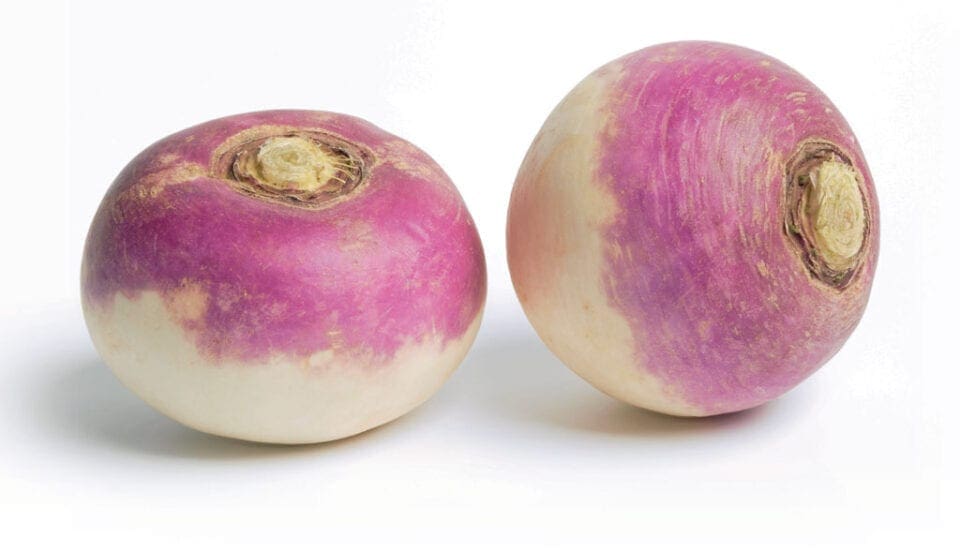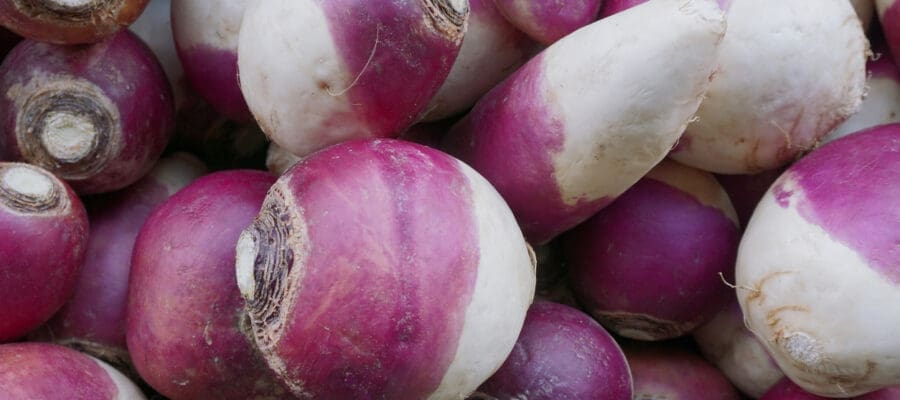Turnips may not be the sexiest of veg, but they are tasty, reliable and fast growing – a great stop-gap and one which you won’t find readily in the shops, says KG editor Steve Ott
They are fast to mature and have a long sowing season. Their leaves can be harvested in spring as an alternative to spinach. Grown in the same way, swedes are a great winter standby.
Turnip varieties
- ‘Aramis’
A purple-topped turnip that is ideal for growing at closer spacings to produce really small roots. - ‘Tokyo Cross F1’
This turnip has an RHS Award of Garden Merit. It is a white turnip that is ready to harvest in as little as 35 days from sowing. - ‘Invitation’
A club root and mildew-resistant swede with great winter hardiness.

Preparation
They may not look much like cabbages and sprouts, but turnips are part of the same brassica family and thrive in similar conditions. They also have the advantage of being in the ground for far less time than many of their leafier cousins.
Some sun during the day is important, although they will tolerate partial shade and shading from taller crops is an advantage in the summer to help prevent bolting if the plants become too hot and dry.
Like other brassicas turnips prefer a firm, reasonably fertile soil, so one that has been mulched with manure or garden compost in the autumn or had similar dug in. This will also help the soil to retain moisture and to keep moisture levels even. This is important to keep the roots growing steadily and not to swell and crack after a downpour following a dry spell.
If your soil is a little deficient in nutrients you can boost nutrient levels by dressing it with a general fertiliser such as Growmore or blood, fish and bone a week or 10 days before sowing.
When to sow turnips & swedes
You can sow seeds from February under cloches outside in mild areas providing the soil is not too wet. Alternatively, if you have a polytunnel or greenhouse border you could choose to sow an early crop there.
Outside on heavy clay in the East Midlands we find it better to hold fire until later in the season when the soil temperature is around 7C (45F).
If you are impatient, you could speed this process and also dry the soil out a little for all early sowings by covering with black polythene from January, but it is better to wait as later sowings will catch up.
Maincrop types or those sown for using later in the season (October/November) are sown in July and August.
Swedes are sown later – from May onwards.
How to sow turnips & swedes
For roots sow thinly in drills (shallow grooves in the soil) about 13mm (½in) deep. Cover with fine soil and water well. If the weather is dry, water the base of the drill before sowing the seeds.
Rows should be 15-20cm (6-8in) apart for early varieties, up to 30cm (12in) apart for maincrops.
Can I grow turnips in containers?
Turnips grow very well in containers and the small, tender early varieties are best for this. You can direct sow very thinly into your container or sow into cell trays and move the plants on once established but before they become restricted or they may bolt rather than produce nice roots.
Choose any well-drained multi-purpose compost for this and give a high-potash liquid feed as the roots start to mature.
Growing on
The seedlings should emerge within 10 days and will develop quickly. Thin in stages until the plants are about 15cm (6in) apart for earlies and 25cm (10in) for maincrop types. The thinnings can be used in salads or stir-fries. If growing for turnip tops (or turnip greens) you do not need to thin the plants.
Maintain watering during dry spells to keep the plants growing as evenly as possible and hoe or hand pull any weeds regularly to avoid competition.
How to harvest turnips

The early varieties can be ready in as little as six weeks from sowing but may take 12 or more depending on the conditions. They are best eaten while still small and tender when they can be grated raw into salads. For cooking they can be allowed to grow a little larger, up to the size of a tennis ball depending on the variety, but very large roots will become woody.
Those grown as maincrops for harvesting from October/November onwards can be left in the ground, but if you garden on heavy, wet soil or where slugs are a problem it is better to lift the roots, remove the leaves and store in boxes filled with dry sand or old potting compost.
For turnip tops (greens) begin harvesting in March/April from a late summer/autumn sowing. Plants used in this way are best covered with cloches when new growth begins in spring to protect the leaves from the worst of the weather.
Roots can be peeled, cubed and blanched in boiling water for two to three minutes before plunging in cold water, drying and freezing in convenient portions for adding to winter dishes.
Watch out for…
As with all brassicas, flea beetles are a common problem with young seedlings. The beetles nibble tiny holes in the leaves, reducing vigour and, in the worst cases, killing the plants. Covering the plants is one option or you can dust the leaves with ground, dry soil to deter them. Alternatively, place sticky insect traps among the rows or brush lightly over young plants.
In severe cases you might consider spraying with an approved insecticide.
Slugs and snails may take their toll on the seedlings and also nibble the roots, reducing quality. Use your favourite form of slug control to keep them in check.
More grow guides
For more growing tips and guides, you should subscribe to Kitchen Garden – you’ll receive free seeds with every single issue too!











